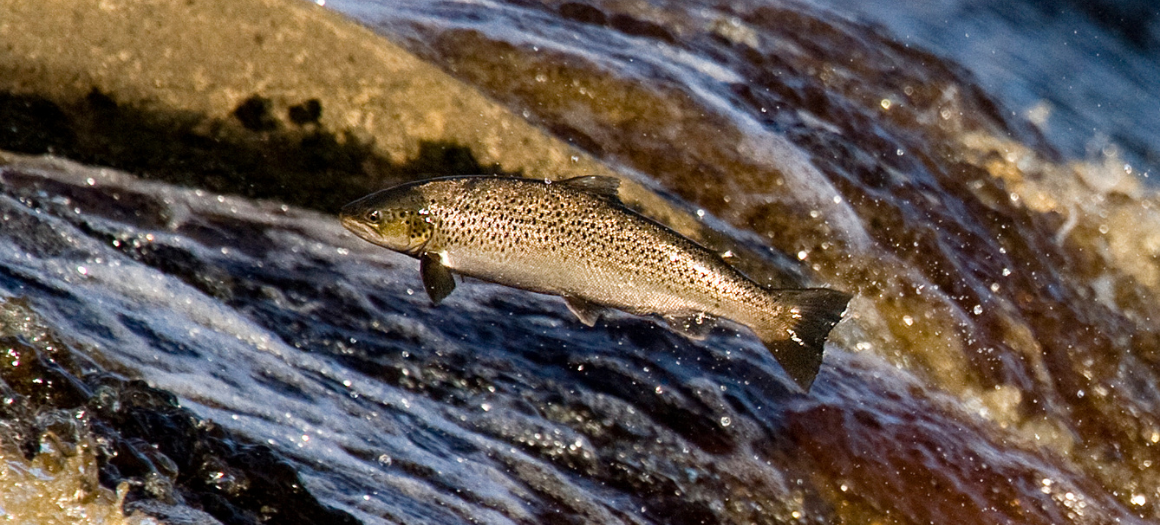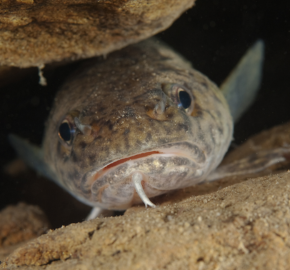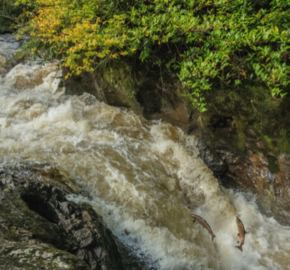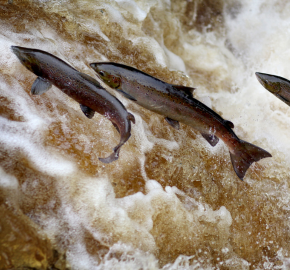The implications of long-distance sea trout migrations on species conservation

Our two native anadromous (fish that migrate up rivers from the sea to breed in fresh water) salmonid species, Atlantic salmon and brown/sea trout are key indicators of the health of the river habitats in which they spawn.
Covering large distances both in their fresh and marine habitats, they are subjected to multiple human-related pressures, including barriers to movement (i.e. weirs, dams), point-source and diffuse pollution, loss of spawning habitat, the negative effects of stocking and capture in target and non-target estuarine and marine fisheries. Faced with a multitude of threats, their populations are sadly in decline.
The SAMARCH project is a collaboration between researchers and partner organisations – like WildFish – in England and France to investigate various aspects of the biology of English Channel populations of Atlantic salmon and sea trout. The group is working together to fill the much-needed information gap and improve the conservation and management of these species.
In this blog post, Dr Andrew King Research fellow at the University of Exeter, explains how the project improves our understanding of sea trout migrations – vital to improving their protection.
Improving the conservation of sea trout
While much is known about the at-sea movements of Atlantic salmon, such detailed information for sea trout is lacking. Sea trout can spend a significant proportion of their life at sea but for such an iconic fish, we know relatively little about the marine phase of their life cycle. The effective conservation and management of anadromous trout requires better data on where sea trout go during their marine migrations.
At the University of Exeter, we have recently published results of a study aiming to improve our knowledge base on marine movements of sea trout in English Channel waters linked to this project. We constructed an extensive genetic baseline and used this as a foundation to look at the origins of migratory trout caught in marine and estuarine waters. Increasingly, DNA markers are being used in fisheries research as an alternative to traditional physical tags. This approach has the advantage over physical tagging in that all fish can potentially be included, as any marine-caught sea trout can be screened with genetic markers. To facilitate this, we worked with local rivers trusts and the Environment Agency to collect samples of resident juvenile trout from 107 rivers. Sampling focused primarily on populations from southern Britain and northern France, and we supplemented this core region with fish from southeast Ireland, northeast England and Denmark. Each fish was screened for variation at 95 genetic markers.
What the study has shown about sea trout populations
Firstly, we examined the structuring of genetic diversity (the pattern of genetic variation within and between populations) in trout population from rivers on both sides of the English Channel. Results indicate strong genetic structuring. At the broadest scale, rivers were split into distinct eastern and western groups, with the split corresponding to a line between the Isle of Portland on the English Channel coast and the Cotentin Peninsula on the northern French Channel coast. It is likely that this pattern is associated with the geology/chemistry of the waters in which these fish live, with the split dividing the more acidic rivers in the western Channel from rivers flowing over chalk bedrock in the eastern part of the English Channel. Each of these two main groups can be further subdivided such that we can recognise 13 distinct genetic groups of wild fish.

Figure 01: Find your favourite river! Genetic relationships between 107 English, French, Irish and Danish rivers, grouped into 13 distinct reporting groups.
We then used the distinct genetic structure apparent in our data as the basis for assigning trout sampled at-sea to their region of origin. As part of the SAMARCH project, we undertook a programme of targeted at-sea sampling, utilising local netsmen at three locations around southern England – Appledore (north Devon), Cawsand Bay (south Cornwall) and Kimmeridge Bay (Dorset). In addition, migratory trout were obtained as by-catch from commercial fisheries in Rye Harbour (Sussex) and along the East Anglian and Dutch coasts, and from recreational fisheries in the Sussex Ouse and along the Upper Normandy coast. Finally, we sampled sea trout caught in estuarine areas of the Taw/Torridge, Tamar, and Frome/Piddle rivers.
The majority of the collections from the English Channel were composed predominately of fish local to the sampling location. For instance, the majority of the sea trout sampled from Cawsand Bay (Plymouth Sound) originated in rivers from along the south Devon and south Cornwall coasts. The collections from Kimmeridge Bay and Rye Harbour were diverse in terms of the origins of the sea trout captured. In total, fish from six different regions were represented here, including fish from two regions of northern France. The two collections from the southern North Sea (East Anglian drift nets, Dutch barrier island fisheries by-catch) were dominated by fish from rivers in northeast England.

Figure 02: Assignment of marine caught anadromous trout from Cawsand Bay (n=58), Kimmeridge Bay (n=25) and Rye Harbour (n = 10) to reporting region of origin. Size of connections between marine collections and reporting region are proportional to number of fish assigned.
The management implications of long-distance movement
Interestingly, the results demonstrate some rare but notable examples of long-distance movements. A few individuals from rivers in the Hampshire Basin were caught in the East Anglian drift net fishery while several northeast English sea trout were caught in the three English Channel fisheries. For the four north east English sea trout sampled from Cawsand Bay (Plymouth Sound), this represents a migration distance of approx. 1000 km from their natal region.
These results have implications for the management of sea trout in inshore waters around the English Channel and southern North Sea. Official data on the incidence of by-catch of sea trout in non-target marine fisheries are very poor but it is clear from our study that they are likely being caught on a regular basis. It is also clear that such by-catch likely represents sea trout from multiple stocks, potentially from multiple countries.
Together with other lines of evidence collected during the SAMARCH project (including acoustic tag data), the genetic assignment results strengthen the evidence that areas such as Kimmeridge Bay and Rye Harbour should be designated as protected areas for sea trout in the English Channel.



